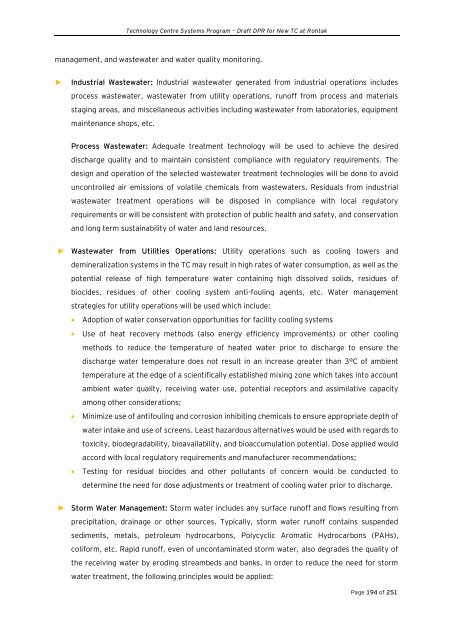Draft Detailed Project Report
Rohtak
Rohtak
You also want an ePaper? Increase the reach of your titles
YUMPU automatically turns print PDFs into web optimized ePapers that Google loves.
Technology Centre Systems Program – <strong>Draft</strong> DPR for New TC at Rohtak<br />
management, and wastewater and water quality monitoring.<br />
►<br />
Industrial Wastewater: Industrial wastewater generated from industrial operations includes<br />
process wastewater, wastewater from utility operations, runoff from process and materials<br />
staging areas, and miscellaneous activities including wastewater from laboratories, equipment<br />
maintenance shops, etc.<br />
Process Wastewater: Adequate treatment technology will be used to achieve the desired<br />
discharge quality and to maintain consistent compliance with regulatory requirements. The<br />
design and operation of the selected wastewater treatment technologies will be done to avoid<br />
uncontrolled air emissions of volatile chemicals from wastewaters. Residuals from industrial<br />
wastewater treatment operations will be disposed in compliance with local regulatory<br />
requirements or will be consistent with protection of public health and safety, and conservation<br />
and long term sustainability of water and land resources.<br />
► Wastewater from Utilities Operations: Utility operations such as cooling towers and<br />
demineralization systems in the TC may result in high rates of water consumption, as well as the<br />
potential release of high temperature water containing high dissolved solids, residues of<br />
biocides, residues of other cooling system anti-fouling agents, etc. Water management<br />
strategies for utility operations will be used which include:<br />
Adoption of water conservation opportunities for facility cooling systems<br />
Use of heat recovery methods (also energy efficiency improvements) or other cooling<br />
methods to reduce the temperature of heated water prior to discharge to ensure the<br />
discharge water temperature does not result in an increase greater than 3°C of ambient<br />
temperature at the edge of a scientifically established mixing zone which takes into account<br />
ambient water quality, receiving water use, potential receptors and assimilative capacity<br />
among other considerations;<br />
Minimize use of antifouling and corrosion inhibiting chemicals to ensure appropriate depth of<br />
water intake and use of screens. Least hazardous alternatives would be used with regards to<br />
toxicity, biodegradability, bioavailability, and bioaccumulation potential. Dose applied would<br />
accord with local regulatory requirements and manufacturer recommendations;<br />
Testing for residual biocides and other pollutants of concern would be conducted to<br />
determine the need for dose adjustments or treatment of cooling water prior to discharge.<br />
► Storm Water Management: Storm water includes any surface runoff and flows resulting from<br />
precipitation, drainage or other sources. Typically, storm water runoff contains suspended<br />
sediments, metals, petroleum hydrocarbons, Polycyclic Aromatic Hydrocarbons (PAHs),<br />
coliform, etc. Rapid runoff, even of uncontaminated storm water, also degrades the quality of<br />
the receiving water by eroding streambeds and banks. In order to reduce the need for storm<br />
water treatment, the following principles would be applied:<br />
Page 194 of 251


